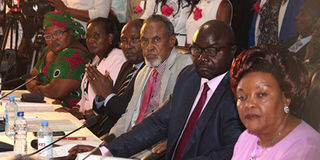Who says young people can’t ‘build bridges’?

Building Bridges Initiative (BBI) committee meets with women's group Embrace Kenya at KICC, Nairobi, on August 8, 2019. PHOTO | FILE | NATION MEDIA GROUP
What you need to know:
- How can the youth even begin to decipher what is required of them when they are not engaged?
- Drop the ‘old guard’ — physically and metaphorically — and bring in the youth leaders to take on positions of influence within these institutions.
Whilst the general public (read politicians, business society of Kenya and the foreigners) are so concerned about the optics of the proposed changes to the Executive and Legislature, thousands, if not hundreds of thousands, of youth entrepreneurs, thought leaders and movers of the economy wonder how they can worm their way into the conversation of yet another government initiative that has ignored them.
With 11 million youth aged 15-24 — a whole 20.92 per cent, or a fifth, of the population — one must wonder why there was a deliberate sidelining of this demographic from the onset of the Building Bridges Initiative (BBI).
Just look at the ‘carefully handpicked’ 16-member task force that steered this ship.
Archbishop Zacchaeus Okoth was born in 1942; Rose Museo Mumo and Major (Rtd) John Seii were both well in the sunset of their glorious careers in the early 1980s.
The only task force that I imagine Bishop Peter Njenga, Prof Morompi ole Ronkei, James Matundura and Bishop Lawi Imathiu (born in 1932!) should be members of is a senior citizens’ one to address retiree matters.
Their average age, going by their achievements and career milestones, is 60.
IGNORED DEMOGRAPHY
Maison Leshoomo joined St Mary’s Primary School in 1970. In 1978, eight years before I was born (I am 33), Agnes Kavindu Muthama tried her hand at marriage.
She is blessed with a 22-year-old Kenyan who might just have been a youth representative in this task force.
Prof Saeed Mwaguni was in Mang'u High School in 1975-76. He obtained his PhD in environmental planning and management in 1980 (roughly 15 years before ‘Generation Y’ were born).
Prof Adams Oloo has been a senior lecturer at the University of Nairobi for 23 years — the age of most youth.
In 2010, there was a heated discussion in Parliament which thrust Florence Omosa to the limelight.
This was probably the day when most Kenyans heard of a PhD in decision science. Dr Omosa is probably the member who is closest in age to the Kenyan youth but she is distant enough not to understand their needs, drive and ambitions.
Senator Amos Wako was born in 1946, a whopping 76 years ago. Senator Yusuf Haji, the task force’s chairman, is 79.
COUTURE SOLUTIONS
If we are going to solve the youth unemployment crisis, we must start by giving them a seat at the table.
If we are going to address issues concerning the youth, the messenger must be of their cloth.
If we have any intention of empowering the youth to take on leadership roles, we must bring ourselves to trust them enough with autonomy to steer the conversations and developments in their spaces.
I was not surprised to note in the BBI report phrases such as (3)(iv): “Promote the respect of elders” — yet another indicator of the lack of youth representation in the project.
I hope against all odds and political biases that the youth will be well represented in the subsequent stages of the BBI.
MENTOR YOUTH
How can the youth even begin to decipher what is required of them when they are not engaged?
Drop the ‘old guard’ — physically and metaphorically — and bring in the youth leaders to take on positions of influence within these institutions.
Is there an assumption that the youth are not capable of the task at hand? Has the government unanimously decided that the youth cannot be instrumental in building a common vision for this country? Try them!
Ms Orwoba-Bjerring is the country manager, Rangi Yetu. [email protected]




